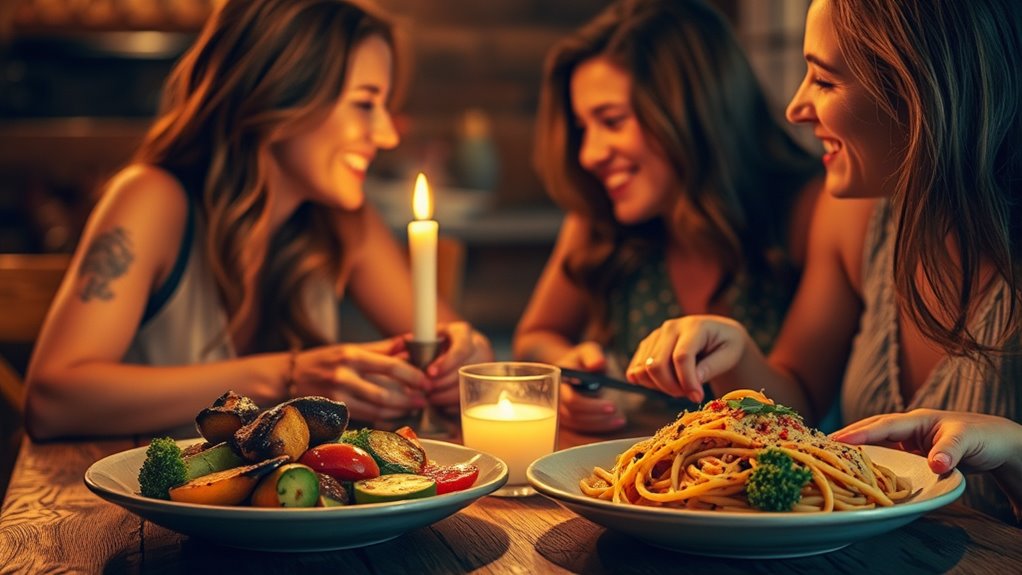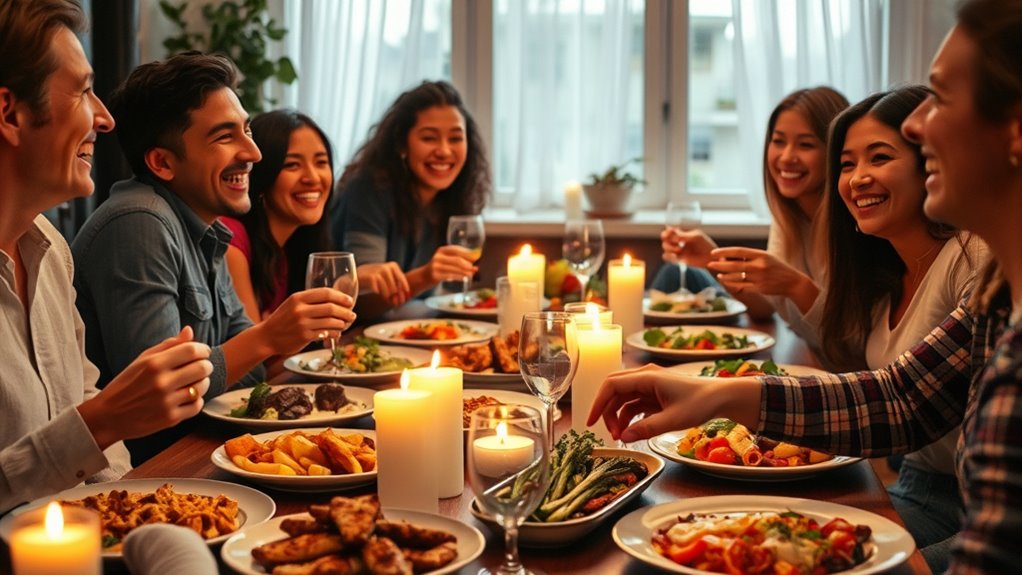Sharing meals creates powerful social rituals that quickly build bonds. When you eat together, you participate in traditions that foster a sense of belonging, trust, and understanding. The physical closeness and shared experiences encourage openness, laughter, and storytelling, deepening emotional connections faster than words alone. These moments reinforce cultural identity and create lasting memories. Keep exploring how these simple acts can strengthen your relationships even more.
Key Takeaways
- Shared meals create a sense of community, fostering emotional connections through collective participation.
- Participating in cultural rituals during meals reinforces identity and deepens interpersonal bonds.
- Eating together promotes openness, eye contact, and storytelling, which enhance intimacy and empathy.
- Rituals during shared dining experiences serve as bonding rituals, strengthening long-term relationships.
- The physical closeness and shared experience reduce social barriers, accelerating trust and connection.

Sharing a meal often goes beyond just satisfying hunger; it creates an environment where people connect quickly and authentically. When you sit down to eat with others, you tap into a powerful social ritual rooted in cultural traditions that have been passed down through generations. These traditions aren’t just about the food itself—they’re about shared experiences, stories, and a sense of belonging. Whether it’s a family dinner, a holiday feast, or a casual get-together, the act of eating together fosters social bonding that words alone can’t achieve. You immediately feel a sense of community, as everyone participates in a common activity that transcends individual differences.
Cultural traditions play a vital role in strengthening these bonds. They provide a familiar framework that makes everyone feel included and connected. When you observe or participate in traditional dishes, rituals, or customs, you’re not just consuming food—you’re engaging in a meaningful cultural exchange. This shared participation reinforces your sense of identity and belonging. The more you immerse yourself in these routines, the deeper your connection with others becomes. Shared meals become a space where cultural stories are told and values are reinforced, making relationships more resilient and genuine. These traditions give your social interactions a layer of significance, deepening trust and understanding among everyone at the table.
Beyond tradition, the act of sharing a meal naturally promotes social bonding. As you eat, you tend to relax and open up, creating a comfortable environment for conversation. The physical closeness and shared experience help break down barriers—whether they’re social, linguistic, or emotional. You find it easier to connect when your focus isn’t solely on the conversation but also on the communal act of dining. This shared activity encourages eye contact, laughter, and storytelling, all of which foster intimacy and empathy. Over time, these moments build a foundation of trust that can extend far beyond the dining table.
In essence, shared meals serve as a catalyst for forging deeper relationships quickly. They turn simple eating into a ritual of connection, rooted in cultural traditions and strengthened through social bonding. When you prioritize these moments, you’re not just nourishing your body—you’re nurturing your relationships, making bonds that endure longer and grow stronger with every shared meal. Additionally, understanding the divorce process in different states highlights how shared experiences, like meals, can serve as a foundation for rebuilding relationships and fostering understanding in challenging times.
Frequently Asked Questions
How Do Cultural Differences Influence the Dinner Date Effect?
Cultural differences greatly influence how shared meals foster bonds. You might find that cultural norms dictate the pace, topics, or expectations during dining, shaping your experience. Dining etiquette varies, affecting comfort levels and connection. In some cultures, communal eating and specific rituals strengthen bonds quickly, while in others, formality might slow the process. Understanding these differences helps you navigate diverse dining situations, making shared meals more meaningful and effective in building relationships.
Can Virtual Shared Meals Create Similar Bonding Effects?
Virtual bonding through shared meals can foster connection, but it requires intentional effort. You can replicate meal rituals by scheduling regular video calls where everyone eats together, creating a sense of togetherness. Engaging in conversation and maintaining eye contact helps deepen bonds. While virtual shared meals may not fully replace in-person interactions, they still encourage meaningful connections and reinforce relationships through shared experiences and ritualistic behaviors.
What Psychological Mechanisms Underlie Shared Meal Bonding?
Did you know that sharing a meal increases trust development by up to 50%? When you dine together, psychological mechanisms like emotional connection strengthen as you synchronize behaviors, share experiences, and foster vulnerability. These interactions activate brain regions linked to social bonding, making you feel more connected. Shared meals naturally promote openness, empathy, and trust, creating a foundation for deeper relationships. This process is powerful whether you’re face-to-face or virtually.
Do Shared Meals Have Long-Term Impacts on Relationships?
Shared meals can have lasting impacts on your relationships by fostering emotional connection and trust development. When you dine together, you create opportunities for open communication, shared experiences, and mutual understanding. Over time, these moments strengthen your bond, making your relationship more resilient. So, regularly sharing meals can deepen your emotional connection, build trust, and contribute to a healthier, more connected relationship in the long run.
How Does the Type of Cuisine Affect Social Bonding During Meals?
Imagine sharing Italian pasta with friends, and you notice how the rich flavors and cozy dining environment help everyone open up. The type of cuisine influences social bonding because it aligns with food preferences, creating comfort and shared experiences. A lively, casual setting encourages conversation, while formal settings might hinder connection. So, choosing the right cuisine and environment can strengthen bonds during meals, making interactions more memorable and meaningful.
Conclusion
Sharing a meal isn’t just about food; it’s about forging connections. Did you know that people who dine together are 50% more likely to feel connected and trust each other faster? So, next time you sit down for a dinner, remember that those shared moments can deepen bonds quicker than you think. It’s not just sustenance — it’s a powerful way to build relationships, one meal at a time.










